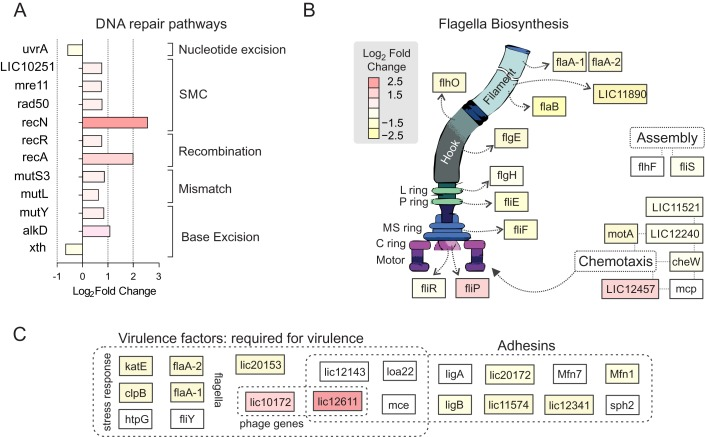Analysis of LexA binding sites and transcriptomics in response to genotoxic stress in Leptospira interrogans.
We determined the effects of DNA damage caused by ultraviolet radiation on gene expression in Leptospira interrogans using DNA microarrays. These data were integrated with DNA binding in vivo of LexA1, a regulator of the DNA damage response, assessed by chromatin immunoprecipitation and massively parallel DNA sequencing (ChIP-seq). In response to DNA damage, Leptospira induced expression of genes involved in DNA metabolism, in mobile genetic elements and defective prophages. The DNA repair genes involved in removal of photo-damage (e.g. nucleotide excision repair uvrABC, recombinases recBCD and resolvases ruvABC) were not induced. Genes involved in various metabolic pathways were down regulated, including genes involved in cell growth, RNA metabolism and the tricarboxylic acid cycle. From ChIP-seq data, we observed 24 LexA1 binding sites located throughout chromosome 1 and one binding site in chromosome 2. Expression of many, but not all, genes near those sites was increased following DNA damage. Binding sites were found as far as 550 bp upstream from the start codon, or 1 kb into the coding sequence. Our findings indicate that there is a shift in gene expression following DNA damage that represses genes involved in cell growth and virulence, and induces genes involved in mutagenesis and recombination.
Authors
Luciane Schons-Fonseca; Josefa B da Silva; Juliana S Milanez; Renan H Domingos; Janet L Smith; Helder I Nakaya; Alan D Grossman; Paulo L Ho; Renata M A da Costa
External link
Publication Year
Publication Journal
Associeted Project
Microbiology or Immunology
Lista de serviços
-
As antisense RNA gets intronic.As antisense RNA gets intronic.
-
Androgen responsive intronic non-coding RNAs.Androgen responsive intronic non-coding RNAs.
-
Conserved tissue expression signatures of intronic noncoding RNAs transcribed from human and mouse loci.Conserved tissue expression signatures of intronic noncoding RNAs transcribed from human and mouse loci.
-
The intronic long noncoding RNA ANRASSF1 recruits PRC2 to the RASSF1A promoter, reducing the expression of RASSF1A and increasing cell proliferation.The intronic long noncoding RNA ANRASSF1 recruits PRC2 to the RASSF1A promoter, reducing the expression of RASSF1A and increasing cell proliferation.
-
Antisense intronic non-coding RNA levels correlate to the degree of tumor differentiation in prostate cancer.Antisense intronic non-coding RNA levels correlate to the degree of tumor differentiation in prostate cancer.
-
Insight Into the Long Noncoding RNA and mRNA Coexpression Profile in the Human Blood Transcriptome Upon Leishmania infantum Infection.Insight Into the Long Noncoding RNA and mRNA Coexpression Profile in the Human Blood Transcriptome Upon Leishmania infantum Infection.
-
Long non-coding RNAs associated with infection and vaccine-induced immunityLong non-coding RNAs associated with infection and vaccine-induced immunity
-
Comparative transcriptomic analysis of long noncoding RNAs in Leishmania-infected human macrophagesComparative transcriptomic analysis of long noncoding RNAs in Leishmania-infected human macrophages
-
SARS-CoV-2 Selectively Induces the Expression of Unproductive Splicing Isoforms of Interferon, Class I MHC, and Splicing Machinery Genes.SARS-CoV-2 Selectively Induces the Expression of Unproductive Splicing Isoforms of Interferon, Class I MHC, and Splicing Machinery Genes.

